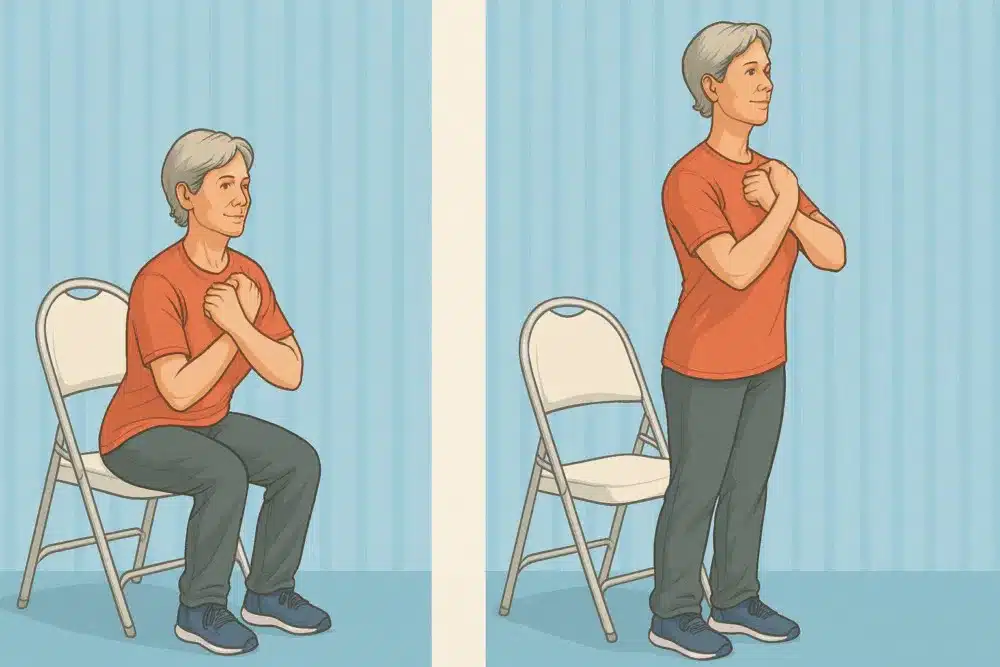Why Do Our Legs Weaken With Age?
Leg weakness is one of the most common complaints as we get older, but it’s not something you just have to accept. There are several reasons behind it, and most of them are within your power to address.
1. Muscle Loss (Sarcopenia)
One of the biggest culprits is sarcopenia, or age-related muscle loss. Starting around age 50, people naturally begin to lose muscle mass, at an average rate of 10–15% per decade. This process affects strength, balance, and stamina.
But here’s the good news: while sarcopenia is common, it isn’t unstoppable. Staying active and doing resistance-based exercises can slow or even reverse it. The key is consistent movement.
2. Reduced Physical Activity
As people age, they often slow down. That could mean fewer walks, less exercise, or simply spending more time sitting. Unfortunately, inactivity creates a harmful cycle: the less you move, the weaker your muscles become, which makes moving even harder.
This slowdown doesn’t just affect strength. It can also worsen circulation, stiffen joints, and contribute to conditions like type 2 diabetes. Simply keeping active—even in small, daily ways—can help protect your legs from that downward spiral.
3. Chronic Health Conditions
Certain long-term health issues also play a role in weakening the legs. Arthritis, diabetes, and peripheral neuropathy are three common examples.
-
Arthritis can limit flexibility and make movement painful.
-
Diabetes can cause nerve damage in the feet and legs, which affects stability and balance.
-
Peripheral neuropathy may make people fearful of falling, which discourages activity and worsens weakness.
Working closely with your doctor, keeping conditions under control, and using physical therapy when needed can help maintain strength and mobility.
4. Back Problems
Sometimes the issue isn’t the legs at all—it’s the back. Conditions such as spinal stenosis, herniated discs, or sciatica can pinch nerves that travel down into the legs, leading to weakness or pain.
It’s tempting to avoid movement when pain flares up, but gentle, guided exercise can help. A physical therapist can suggest activities that relieve pain while keeping your legs strong. If you ever experience sudden numbness, tingling, or extreme weakness, it’s important to seek medical advice quickly.
5. Emotional and Lifestyle Factors
It’s not just physical health that affects leg strength. Emotional well-being matters too. Retirement, depression, grief, or loss of routine can rob people of motivation to stay active.
Without purpose or encouragement, it’s easy to stop moving as much, and the legs pay the price. This is where community and support make a difference. Exercising with a friend, joining a fitness group, or even just walking with family members can rebuild confidence and consistency.
Key Reminders
Although leg weakness is common with age, it is often reversible. Staying active is your strongest defense. Managing health conditions, looking after your back, and having a strong support system also play vital roles.
Think of your legs as your foundation. The stronger they are, the more independence, confidence, and freedom you’ll have in your daily life.
Simple Home Exercises for Stronger Legs
You don’t need a gym or fancy equipment to keep your legs strong. These simple, at-home exercises can make a big difference:
-
Chair Stands: Sit in a chair, then rise to a standing position slowly and sit back down. Start with using your hands for support if needed, then try without.
-
Lunges: Step forward with one foot, bend your knees, and lower yourself gently before pushing back to standing. This works each leg individually and challenges balance.
-
Walking: Don’t underestimate walking. Start with short distances on flat ground. Over time, add hills or trails for variety. Use a cane or walker if you need stability.
The key is consistency. A few minutes each day is more powerful than a long workout once in a while.
Final Thought
Weak legs don’t have to be an inevitable part of aging. With awareness, activity, and support, you can maintain strength and independence for years to come. If you’re unsure where to start, don’t hesitate to ask your doctor or a physical therapist for guidance.
Remember: every step you take today is an investment in your freedom tomorrow.






